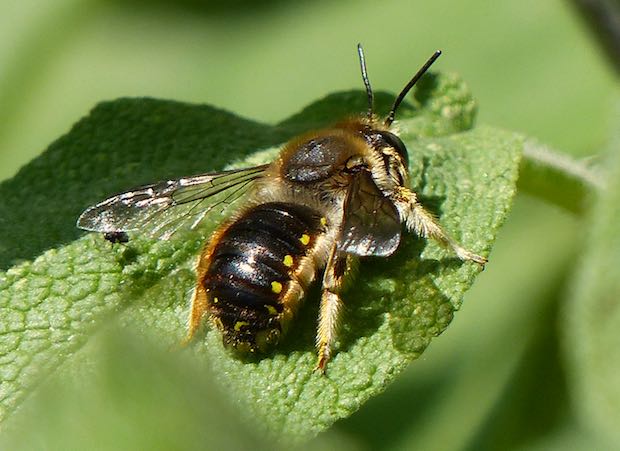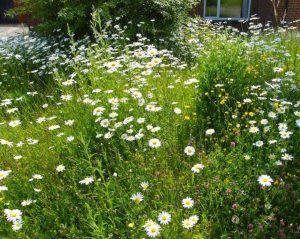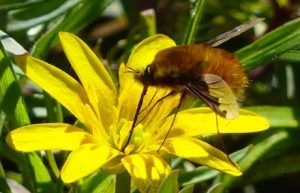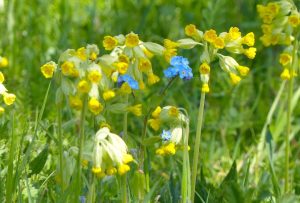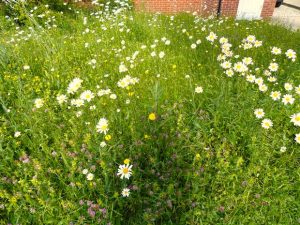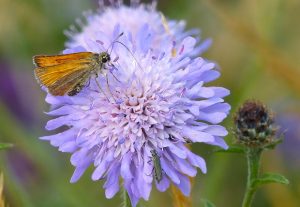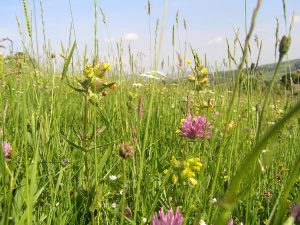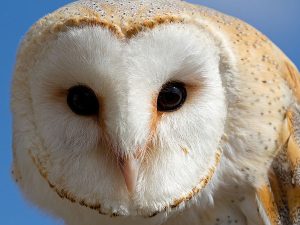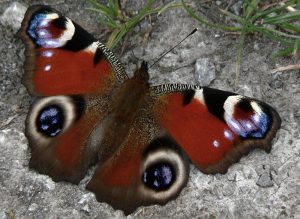Jo Cartmell of NearbyWild shares Part 6 of her mini meadow series. This time, she has a close encounter with two very special guests to her garden: a wool carder bee and leafcutter bee.
I am amazed to discover there are over 270 bee species in Britain and Ireland and that bumblebees and honey bees only account for about one tenth of that figure. The wool carder and the leafcutter bees belong to the Megachile (leaf-cutting bee) group.
Both the wool-carder and the leafcutter are solitary bees. They nest in walls, as well as in dead wood and bee hotels provided by us. Wool carder bees also nest in hollow stems whereas leafcutters will occasionally use soil, twigs and the hollow stems of brambles. They are impressive engineers, magical to watch and this year my dream of seeing a wool carder bee came true.
Wool carder bees arrive in the orchard meadow for the first time
As I enjoy watching wildlife in the orchard meadow, a wool carder bee catches my eye and begins feeding on purple toadflax. I run for the camera in excitement. Although I have never seen one before, it’s identity is confirmed by the distinctive yellow dots along the side of its body which I glimpse through the lens as it swiftly flies from flower to flower to extract nectar. It is thanks to one of Brigit Strawbridge’s blog posts that I am even aware the wool carder bee exists and that my dream of encountering one comes true.
As I watch this robust, medium-sized, highly territorial solitary bee, it frequently aggressively flies towards approaching insects. It is characteristic behaviour. In an aerial battle, it will apparently head butt and wrestle to ward off another insect, but to see this fascinating behaviour you would have to film it in slow-motion. If the intruder is undeterred, the bee will use spines at the end of its abdomen to crush its opponent. Yet, they are totally harmless to humans and are such a transporting, mood-changing delight to watch.
This bee’s name is derived from the habit of gathering the hairs of the leaves of various downy plants, including lamb’s ear (Stachys byzantina) and flower of Jupiter (Lychnis flos-jovis). It cards the hairs of these plants into a ball and then flies off with them to line brood cells. It is active from late May when it emerges from its cell, until early August.
You only have to step out of your back door to get the most exciting action at times, if you have wildlife habitat such as wildflower meadows, orchard meadow, ponds, hedgerow and log piles. They were discovered in Ireland this year, but are becoming scarce elsewhere.
I have not had the privilege of seeing hairs being carded by these amazing little bees yet, so I planted some lamb’s ear during September in the hope of being able to capture this rarely caught behaviour on camera. Wool carder bees are strongly associated with labiate flowers, especially the woundworts (including garden lamb’s ear) and black horehound.
This bee, though, was visiting purple toadflax which has self sown into the orchard meadow and is in the film clip. Although it is a non-native plant, introduced and first recorded here in 1831, it is long flowering and was abundant on my father’s grave. So there is a beautiful reminder of my wildlife-loving father each summer by leaving it in the orchard meadow.
Who made those semi-circular holes in the garden roses?
A few days later, I notice the perfectly named patchwork leafcutter bee flying back and forth to a small hole made by a masonry drill in the garage wall. It looks rather impressive as it arrives clasping an oblong leaf to line the cell and makes many trips to harvest pieces of leaves. It sticks the leaves together with saliva and provisions the cell with a runny mixture of nectar and pollen.
When it is completed, an egg is deposited there and the entrance is sealed with a circular leaf. This process is repeated a number of times and the offspring emerge the following May. Amazing. As you can see in the film clip they are impressive engineers and are magical to watch at work or in flight.
As Brigit Strawbridge inspiringly tweeted on Twitter:
“Rejoice if your leaves look like this; it means your garden is supporting leafcutter bees – they are very important pollinators!”
Like so many other leafcutter species, they are often found on bramble or thistle flowers. These charming solitary bees, butterflies and other insects are visiting knapweed in a local wood meadow. At 50 seconds in this film you can clearly see on the underside of the leafcutter bee the beautiful dense orange hairs (scopa) on which it collects pollen.
So, if you plant common knapweed, or sow a mini meadow which includes my favourite firework of a wildflower – greater knapweed – in unused lawn areas, it will help many species to thrive, including leafcutter bees.
Asking your council to mow grass verges and unused green spaces once in mid to late August and once in March at latest will also help them to thrive, as this regime will provide the wildflowers and meadow grasses that these and other insects such as butterflies need.
If you would like to purchase wildflower seed to attract wool carder or leaf-cutter bees and greatly increase biodiversity, please see NearbyWild’s Get started page for suppliers and advice on how to establish an orchard. If you have enough space, an orchard meadow is such a sustainable, life-giving gift for wildlife which will provide fruit for you, your family and friends to enjoy year after year. So will the wildflowers and meadow grasses, as they sow their own seeds which you can also share with family and friends.
This article is kindly reproduced with permission from an original post by Jo Cartmell at NearbyWild. Photos and text are the author’s own unless otherwise specified.

Photo by Katharine Bird.
About the author
Wildlife photographer, amateur ecologist and wildlife conservationist Jo Cartmell’s passion for British wildlife began in early childhood. Her special interests are water voles and wildflower meadows. Jo contributed to Spring, Summer and Autumn: An Anthology for the Changing Seasons and has had articles published in the Ecologist. She started @WaterVole on Twitter in 2009 and @NearbyWild in 2015. Jo is a regular contributor to NearbyWild, along with Stephen de Vere who runs the website, contributes, advises Jo on her blogs and films the Quick Guides.

